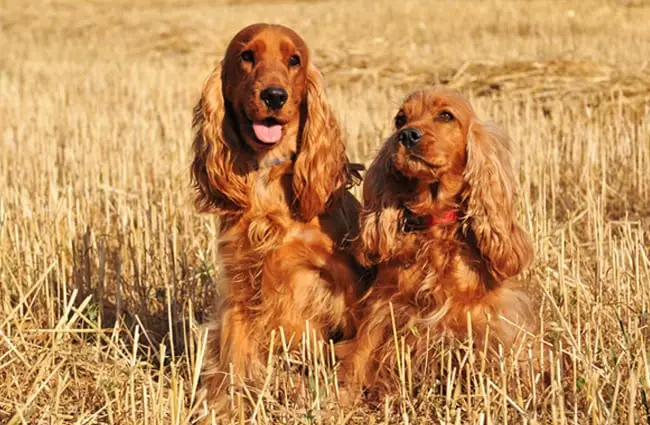The cocker spaniel, also known as the “cocker,” is a lovable and cheery dog that was originally bred for hunting. Nowadays, this breed is much more popular as an all-around pet that excels at cuddling and training. These dogs have a long, silky coat that requires regular grooming. With an adorable face and a winning personality, it’s no wonder this breed is so popular. Read on to learn more about the cocker spaniel.
Description of the Cocker Spaniel
Popularized by the famous Disney movie, Lady and the Tramp, the cocker spaniel is far more ancient than television. This breed was developed in Spain as a woodcock hunter (hence the name “cocker”).
The AKC separates the cocker spaniel into two distinct breeds: the American and the English. The American variety is known for having a rounder face and longer coat, and is more of a true pet dog. The English cocker is taller with a shorter coat, and is more similar to the original hunting dog.
Both varieties of the breed have long, floppy ears that frame an alert face. These dogs should be cheerful, friendly, an eager to work. They are surprisingly athletic below their incredibly long coats.
The American cocker spaniel comes in a variety of colors and markings, though black, brown, tan, buff, and red are the most common colors. The American cocker may also have white or tan markings, depending on the base coat color. The English cocker spaniel may come as black, blue roan, golden, lemon roan, liver, orange, or red, with a variety of acceptable markings in tan or white.
Life Expectancy and Size
The cocker spaniel generally lives into its early to mid teens. The American variety is slightly less long-lived, with an average lifespan of 10-14 years. The English cocker generally lives 12-14 years.
The American cocker spaniel stands 13.5 to 15.5 inches tall, with males standing about an inch taller on average. This breed weighs between 20 and 30 pounds, with males generally weighing five pounds more than the females.
The English cocker spaniel is slightly larger. They stand 15 to 17 inches tall, again with the males about an inch taller than the females. They weigh 26 to 24 pounds, with the females a bit lighter than the males.
Protective Ability
This breed is known for its merry attentiveness and trainability, not its guard dog instincts. With a well-earned reputation of loving people, and being outgoing with strangers, the cocker spaniel is not a natural choice for personal protection. Their trainability means you certainly can train a cocker to guard the house – but if you want a guard dog, look at larger and more naturally suspicious dogs.
Training
The cocker spaniel is known for intelligence and responsiveness. They are a joy to train, quickly picking up on obedience and tricks alike. That said, they are so quick to learn that it’s easy for them to pick up on bad habits if you’re not careful!
Carefully manage your dog’s environment to avoid him learning the wrong lessons. For example, be sure to lock up the trash and avoid letting your puppy jump on people, or you’ll have a hard habit to break. With a dog as attentive and clever as the cocker spaniel, you’ll do best using reward-based training to reach their full potential. Correction-based training can muffle their spirit and reduce their drive to learn.
Cocker Spaniels excel at almost every dog sport out there, from agility to dock diving. They are natural athletes that generally love fetch and swimming.
Energy Level
The cocker spaniel, despite his dashing looks, is still an athlete at heart. These dogs require daily exercise, and can quickly turn to bad habits when under-challenged. Pair long walks with more rigorous exercise, like fetch or swimming, and let your cocker play with puzzle toys to earn his meals.
The American cocker spaniel is generally slightly lower-energy than the English cocker spaniel.
What Living with a Cocker Spaniel is Like
Spaniels in general are good options for first-time owners. The cocker spaniel is generally the easiest spaniel breed, thanks to his smaller size and relative genetic distance from his time as a full-time hunting dog.
Living with a cocker spaniel is an adventure! These active dogs are generally affectionate and exploratory, excited to learn and be around you. They are excellent hiking or training companions.
This breed is a good option for families with children, elderly owners, and everyone in between. They do require regular grooming, but otherwise this cheerful dog is a pretty easy companion to share your life with.
Care of the Cocker Spaniel
The cocker spaniel can excel in most environments, when provided proper grooming and training.
Environmental Needs
The cocker spaniel’s extensive coat means that he does not generally do well in extreme heat. If you live in a hot area, be sure to keep your dog cool by avoiding exercise during the hottest parts of the day. This breed should not be shaved, as this can ruin its coat, and it will not grow back correctly.
Exercise Needs
As a former hunting dog, the cocker spaniel requires ample exercise. They are notoriously bouncy, enjoying fetch, jogging, playtime, and swimming in general. At a minimum, the cocker spaniel needs a long walk every day, and some puzzle toys to exercise his clever mind. This breed needs more exercise than access to a back yard provides. You’ll have to put in some miles to tire out this dog!
Shedding and Grooming
Shedding and grooming are the most challenging parts of caring for a cocker spaniel. This breed should not be shaved, meaning they will need regular and extensive brushing and trimming instead. Most owners opt to learn how to use a slicker brush and dematting tool almost every day. A few times a month, use grooming shears to trim the long hair around your dog’s eyes, ears, neck, toes, and belly.
The ultra-long hair around their chests and bellies can be quite a pain to keep clean, so many owners opt to trim this shorter – though again, do not shave this area. This can be quite challenging for inexperienced groomers, so be sure to take your dog in if you’re not comfortable with this yet.
The cocker spaniel’s ultra-long ears are prone to infection, so regular ear cleaning is a must for these dogs.
Ideal Home Environment
This breed is popular with almost every sort of home out there. Whether you are looking for a good dog to be around kids, or to keep you company as you age, the cocker spaniel will fit nicely into your home. This dog can fit into athletic and training-focused families, or accompany lower-energy families on long walks.
Ask your breeder whether their dogs are best suited for “working” or “pet” homes, as the working dogs will have much more energy than the “show” or pet homes.
These dogs can have a high drive to chase prey, including squirrels and birds. For this reason, it’s best to not leave them unattended without a secure fence. They can be trained to walk off-leash, but a leash is always the best way to ensure your dog doesn’t dash off after a bunny.
Health Concerns
This breed is generally quite healthy. Ask your breeder to see proof of an eye and hip exam before bringing home a puppy. English cockers should also have knee tests done. If your breeder doesn’t have these tests, look elsewhere to ensure that you’re bringing home a healthy puppy and supporting responsible breeding.
One extremely rare, but concerning health problem in the cocker spaniel is known as “cocker rage syndrome.” This condition likely has a genetic component, but is poorly understood. This problem is most common in male cockers that are red or blonde in color. The name “cocker rage syndrome” has fallen out of favor lately, as researchers discovered that the issue is not limited to cocker spaniels.
The issue is now more commonly known as Sudden Onset Aggression. It generally shows up between six months and two years of age. The terrifying issue manifests as dogs that react with disproportionate aggression in situations such as being disturbed from a nap. Minutes later, the dog is generally completely relaxed, as if nothing has happened.
In some cases, anti-seizure medication can help dogs with Sudden Onset Aggression. However, in other cases, no treatment is effective, and euthanasia is the only humane and safe option.
Behavior Problems
Aside from Sudden Onset Aggression, which is undoubtedly a very severe concern, this breed is not known for behavior issues. Sudden Onset Aggression is extremely rare, and most trainers have never seen a case – it’s unlikely you will ever see it.
In most cases, simply researching your breeder, attending puppy kindergarten, and focusing on rewarding good choices in your dog (while not allowing your dog to practice bad behaviors) will produce a stereotypically happy and easygoing cocker spaniel.
















![Red Angus Closeup of a beautiful Red Angus cowPhoto by: U.S. Department of Agriculture [pubic domain]https://creativecommons.org/licenses/by/2.0/](https://animals.net/wp-content/uploads/2020/03/Red-Angus-4-100x75.jpg)

